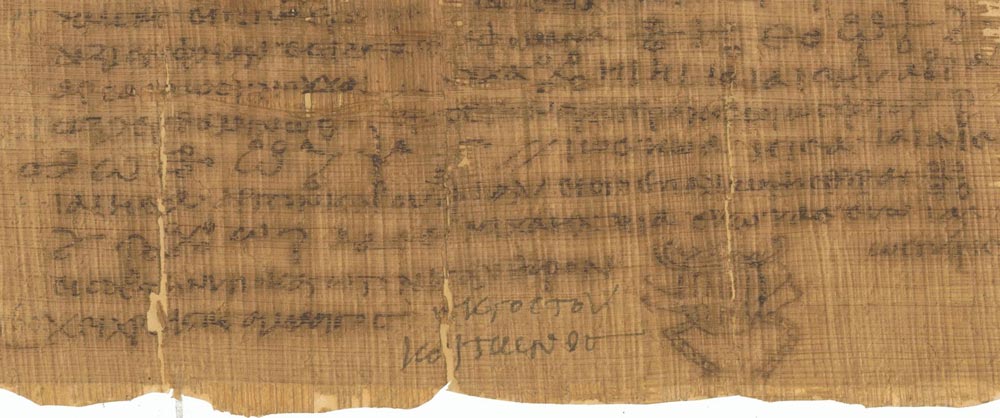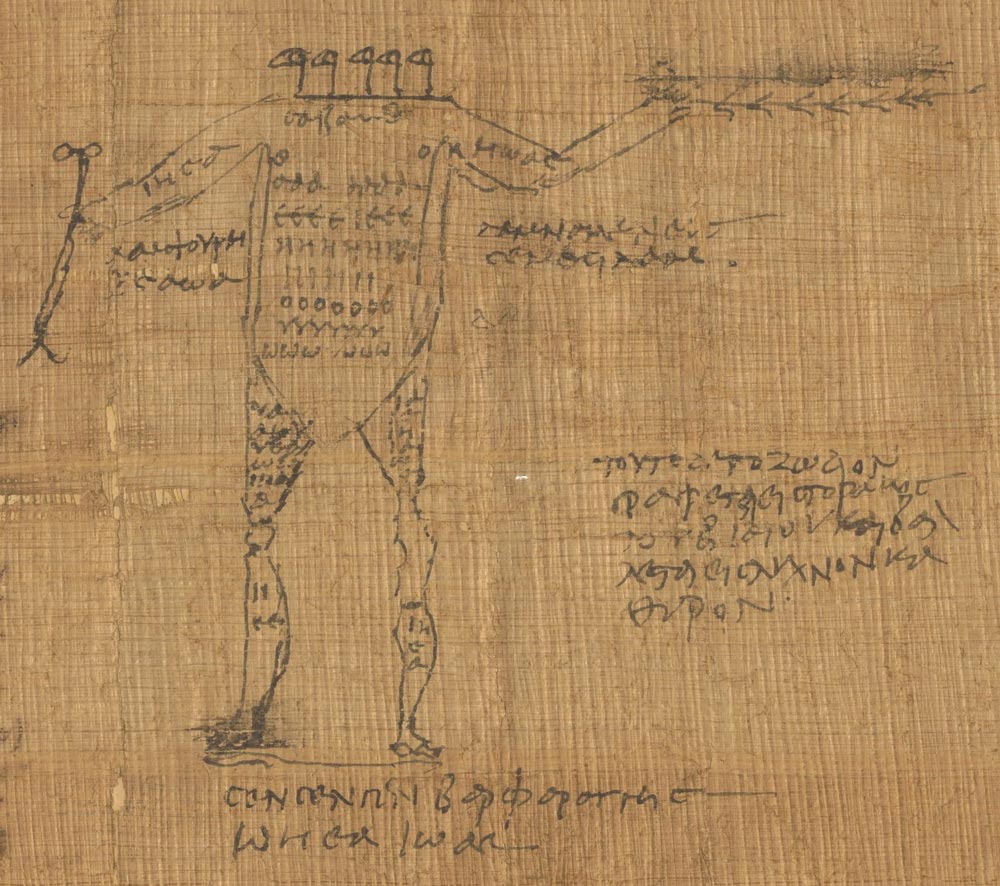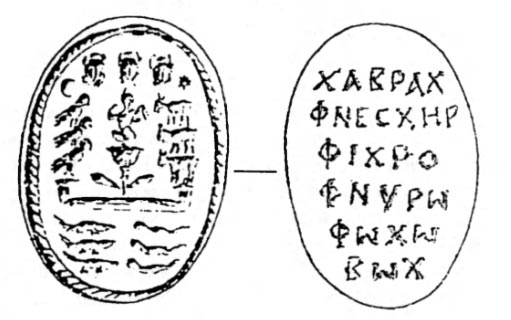Updated version 4.0
During my work on a functional version of the Stele of Jeu for ritual use based on the German translation by Preisendanz1 and his monograph Akephalos - The Headless God2 I hit a massive roadblock.
The ritual requires a formula of 6 names to be written on a parchment and recited facing north. But it surprised me to find no actual mention of these names in the text.
Isaac's Sabaoth
According to what I have seen in books, articles, and online discussions, all modern practitioners use the following voces magicae as the required formula:
AŌTH ABRAŌTH BASYM ISAK SABAŌTH IAŌ
This seems to work well enough for modern chaos magicians. But in the original PGM text there is no indication whatsoever that above words are the formula to be used. These six words are merely the only row of six subsequent voces magicae to be found in this spell3.
On top of that, above transliteration has a typo. It's supposed to be ABAOTH and not ABRAOTH. An observant reader has pointed out in the comments that both, this typo and this choice of six names, are most likely traceable to the book Hermetic Magic: The Postmodern Papyrus of Abaris by S. E. Flowers4.
I checked the sources and found that when the spell was first published5 in 1852 by Charles Goodwin it did not contain any transliterations of barbarous names. And as preliminary invocation in The Book of the Goetia of Solomon the King6 by Aleister Crowley the spell neither had this typo, nor any special meaning attributed to these six words. But then again, Crowley was also quite liberal in his translation and adaptation of the spell.
So back to the original source. If you'd want to be persnickety like Preisendanz, who interpreted BASYM7 not as a name but as the Aramaic word "ba'shem" or "in the name of", it would only leave five names, wouldn't it?
According to the work "Abrasax" by Reinhold Merkelbach and Maria Totti8 from 1991 which includes a number of PGM spells with commentary, AOTH and likely also ABAOTH are shorter forms of SABAOTH. This means that the string of "barbarous names" reads as:
(SAB)AŌTH, (S)ABAŌTH, in the name of ISAAC('s) SABAŌTH-IAŌ
The Orphic Formula
In Betz' Greek Magical Papyri in Translation9 you can find a footnote regarding the six names:
The term ὄνομα apparently refers to a formula containing a number of magical words.
At this point in my research, I considered the possibility that the original author of the papyrus was referring to a formula so obvious and well known to magi at the time that simply mentioning "the six names" would have been enough for the reader to understand what was meant. What supports this idea is the fact that throughout the PGM, some voces magicae that are commonly used are just noted down as "do the usual" or as abbreviations, e.g. "ABERAMEN (formula)" in PGM IV, 182 actually refers to the palindrome:
ABERAMENThŌOULERThEXANAXEThRELUOŌThNEMAREBA
(See also Leonardo Drakon's awesome post on this)
But what could be the well known "six names"? One of the most famous magical hexagrammata of the time that can be found on numerous talismans and in other protective magical contexts in dozens of places between Egypt and Sicily are the Ephesia Grammata, also called Orphic formula. This terminology can also be found in PGM VII, 452:
But if you cause [the plate] to be buried or [sunk in] river or land or sea or stream or coffin or in a well, write the Orphic formula, saying, "ASKEI KAI TASKEI" and, taking a black thread, make 365 knots, ...
The six names of the "Ephesia Grammata" are:
ASKION KATASKION LIX TETRAX DAMNAMENEUS AISION
I highly recommend the awesome paper The Ephesia Grammata: Logos Orphaikos or Apolline Alexima pharmaka? by Radcliffe G. Edmonds III. and this great post over at the Hekate Covenant on a different version of the Ephesa Grammata that is being used in the PGM.
While the orphic formula is indeed a powerful choice that would make much more sense to use instead of the widespread Isaac Sabaoth one discussed above, this is not the end of the story...
Scarab Hunt
The German Preisendanz translation1 has a very interesting footnote regarding the "6 names". It claims that the original papyrus contains an annotation about the missing formula! Betz had merely hinted at this. The Preisendanz footnote says:
"On the upper edge of the column is written the (damaged) name ...AIE AIŌI EYIAE AEI ŌŌE AIEOYEYŌ... [and that] the formula is 49 letters long and has a value of 9999 ... reference to a different spell about resurrection of a scarab that has the same name with 49 letters."
 (damaged note on the edge of the London Papyrus 46 aka. PGM V)
(damaged note on the edge of the London Papyrus 46 aka. PGM V)
I also asked my friend Spiro who knows Greek to take a look at it and he interprets the annotation as something along the line of :
αιη αιωι ηυιαη αη ιω ωη αιηουευω ... ιωη οαυ αεη υωυω. And this is what the revived words of the scarab call for.
I found some spells in the same papyrus that involve a scarab: PGM V 213-303 which is neither about a resurrection of the beetle, nor does it have any voces magicae in it. Another one is PGM VII, 505-28 which features the 48 letter long magical name "AŌ SATHREN ABRASAX IAŌAI AEŌ ĒŌA ŌAĒ IAO IĒO EY AĒ EY IE IAŌAI", but isn't about resurrecting the bug. The only spell about actually reviving a scarab in the PGM is number IV, 475-829 but it only contains very short barbarous names.
But eventually I found something:

PGM II. 64-183 features a drawing of a scarab at the bottom edge. The described ritual is an "alternative procedure" of a conjuration of Apollon-Helios for wisdom and blessing. Especially when you look at the original papyrus (Berlin P. 5026) you will find it in the third column on the bottom.
And guess what image is drawn right next to this column? A HEADLESS figure! The same one that Jake Stratton-Kent used on his little "Headless One" chapbook.

In the middle of the column above the scarab (PGM II. 127) it is written:
I am he, NN, who have presented myself to you, and you have given me as a gift the knowledge of your most great name, of which the number is 9999: IĒ IE IA IAĒ IAE IEY IĒA IŌA IEY IĒI ĒIA EA EĒ ĒE ŌĒ ĒŌ EĒE EEĒ ĒEE AAŌ ŌEA EAŌ ŌI ŌE ĒŌ EĒ EAE III OOO YYY ŌŌŌ IY EY OY ĒEA IĒEA EAE EIA IAIE IĒA IOY IŌE IOY IĒ IĒ IĒ IĒIE;
Sounds familiar? Of course it does! Vowels!
Is this the formula the author was referring to in the scribbled note regarding the scarab?
Perhaps the annotation on the Stele of Jeu papyrus was done hastily. The author might have remembered that the name to be used was "on that scarab whatever page", that it enumerates to 9999 and consists of something along the line of "...AIE AIŌI EYIAE AEI ŌŌE AIEOYEYO...".
I threw the Greek letters from Preisendanz transcript into an isopsephy (Greek gematria) calculator but they add up to 15446. Weird...did I miss something?
When I cross-checked Kieren Barry's "Greek Qabalah"10 for the correct isophsephic values I stumbled upon the solution by coincidence.
There it was! I found it on page 96:

A talisman that features an image of Harpocrates (Horus) seated on a lotus flower surrounded by triads of adoring animals; on its reverse, the formula:
χαβραχ φνεσχηρ φιχρο φνυρω φωχω βωχ
A magical formula apparently known as "The Great Name" which gematrically adds up to 9999!
And it was there all the time!
This exact formula is written shortly AFTER the above mentioned vowels in the middle of the column with the scarab on it! It is mis-spelled and the whitespace is off, and due to the typo it actually doesn't add to 9999 but only 8139
χαβραχ φλιεσ κηρφι νυρω φωχω βωχ
According to footnote 39 in Betz9:
The spacing of this formula has been changed to conform to the spacing of the same formula found elsewhere in the PGM (see I. 141—42; III. 77—78, 151-52 , etc.)
the editor also erroneously "fixed" it to:
CHABRACH PHLIESKĒR PHIKRO PHINYRŌ PHŌCHŌBŌCH
Instead, the correct formula of the six names that add up to 9999 that the scribe hastily (or purposefully?) mis-spelled are actually supposed to be written like this:
χαβραχ φνεσχηρ φιχρο φνυρω φωχω βωχ
CHABRACH PHNESCHĒR PHICHRO PHNYRŌ PHŌCHŌ BŌCH
BINGO!
Chimeric Splicing
Now, the perfectionist in me wondered: what about the vowels from the annotation?
I remembered that in Merkelbach/Totti's Abrasax8 the authors offer a slightly different take on the annotation:
On the upper edge an annotation; First a series of vowels, then: These are (in total) 49 letters; the sum of the calculation is 9999.
No mention of a scarab here. According to the authors, it's the vowels that are supposed to add up to 9999.
Sure...let's do this...
Minus whatever vowels got lost from the torn corner of the papyrus we still have 39 vowels that add up to a gematric value of 8291. That leaves us with ten missing vowels that need to add up to 1708 to reach the required 9999.
I spent over an hour trying to splice the missing vowels into the ones we already have - and I failed!
It was just impossible to create an isopsephy value of 1708 with just 10 vowels and possible values of 1, 5, 8, 10, 70, 400, 800 without deleting any of the letters that we already have. Aaarrgh!
So I went full OCD and looked back at the original papyrus and deciphered the handwritten letters myself. I noticed that the first ypsilon (in ĒYIAĒ) seems to have been actually quite a guess by Preisendanz. More than half of the letter is missing at the top. It could totally also be another letter the scribe does not necessarily write in the full line height, for example a miniscule omega.
So I tried again with ĒŌIAĒ in the series of vowels instead of ĒYIAĒ:
αιη αιωι ηωιαη αη ιω ωη αιηουευω ιωη οαυ αεη υωυω
This leaves us with a value of 8691 and 1308 missing. Back to the splicing table. Eventually I got it!
If we add 1 omega, 1 ypsilon, 1 omicron, 3 iotas, 1 epsilon, and 3 alphas to get from 39 letters to the required 49 we reach an isopsephy sum of 9999!
To put these new letters into a meaningful combination I tried for quite a while to make them adhere to the following rules:
- they need to sound nicely and in tune with the existing vowels when vibrating the whole series
- be made up of realistic vowel combinations that already exist in the PGM, and
- hypothetically fit into the empty space of the missing papyrus corner.
I eventually succeeded! Here is the chimerically spliced vowel series of the annotation:
αιη αιωι ηωιαη αη ιω ωη αιηουευωαι εαι υο ιαω ιωη οαυ αεη υωυω (9999)
and a photoshopped version of the papyrus itself:

Conclusion
Unfortunately the London Papyrus 46 with the annotation is torn on the edge, so we will never know what it really said but the reference to the scarab papyrus makes sense. Dfinitely more so than repeating the completely randomly chosen "AŌTH ABAŌTH BASYM ISAK SABAŌTH IAŌ" formula.
So, why not use the magically resurrected 49 vowels of the annotation in addition to the famous greatest name that both enumerate to 9999:
AIĒ AIŌI ĒŌIAĒ AĒ IŌ ŌĒ AIĒOYEYŌAI EAI YO IAŌ IŌĒ OAY AEĒ YŌYŌ
CHABRACH PHNESCHĒR PHICHRO PHNYRŌ PHŌCHŌ BŌCH
I guess the only solution to the missing formula is the magic solution: take it, use it, experiment with it, and see where it will take you!
-
Preisendanz, Karl, "Papyri graecae magicae", Band 1 (Leipzig, 1928) ↩↩
-
Preisendanz, Karl, "Akephalos. Der kopflose Gott", Beihefte zum Alten Orient 8 (Leipzig: Hinrichs, 1926) ↩
-
Someone on /r/occult had an interesting dissection of the 6 word name AŌTH ABRAŌTH BASYM ISAK SABAŌTH IAŌ. ↩
-
Flowers, Stephen E. "Hermetic Magic: The Postmodern Papyrus of Abaris." Maine: Red Wheel/Weiser, 1995. Archive Copy ↩
-
Goodwin, Charles Wycliffe, ed. Fragment of a Græco-Egyptian Work Upon Magic: From a Papyrus in the British Museum. No. 2. Deighton, 1852. Archive Copy ↩
-
Crowley, Aleister, and Solomon (King of Israel.). Goetia. First Impressions, 1904. Archive Copy ↩
-
בְּשֵׁם, [b'shem] derived from בְּ־ in; by and שֵׁם name. ↩
-
Reinhold Merkelbach, Maria Totti, "Abrasax: Ausgewählte Papyri religiösen und magischen Inhalts", Sonderreihe Papyrologica Coloniensia, 1991 ↩↩
-
Betz, ed. by Hans Dieter (1992). "The Greek magical papyri in translation including the Demotic spells" (2nd ed.). Chicago: Univ. of Chicago Press. ↩↩
-
Kieren Barry, "The Greek Qabalah: Alphabetical Mysticism and Numerology in the Ancient World", 1999 by Red Wheel Weiser ↩
